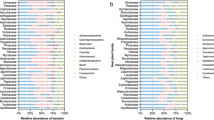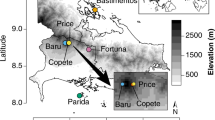Abstract
The diversity and factors influencing fungal assemblages in phyllosphere of Mediterranean tree species have been barely studied, especially when endophytic and epiphytic communities are simultaneously considered. In this work, the endophytic and epiphytic fungal communities from olive tree phyllosphere were studied. This tree species is natural from the Mediterranean region and adapted to grow under adverse climatic conditions. The main objectives were to determine whether there are differences between both fungal communities and to examine whether different abiotic (climate-related) and biotic (plant organs) factors play a pivotal role in structuring these communities. Both communities differed in size and composition, with epiphytic community being richer and more abundant, displaying also a dominance of melanized fungi. Season was the major driver of community composition, especially of epiphytes. Other drivers shaping epiphytes were wind speed and temperature, while plant organ, rainfall, and temperature were the major drivers for endophytic composition. In contrast, canopy orientation caused slight variations in community composition of fungi, but with distinct effects in spring and autumn seasons. In conclusion, epiphytic and endophytic communities are not driven by the same factors. Several sources of variation undergo complex interactions to form and maintain phyllosphere fungal community in Mediterranean climates. Climatic parameters have influence on these fungal communities, suggesting that they are likely to be affected by climate changes in a near future.





Similar content being viewed by others
References
Lindow SE, Brandl MT (2003) Microbiology of the phyllosphere. Appl Environ Microbiol 69:1875–1883
Berg G, Grube M, Schloter M, Smalla K (2014) Unraveling the plant microbiome: looking back and future perspectives. Front Microbiol 5:148
Moricca S, Ragazzi A (2008) Fungal endophytes in Mediterranean oak forests: a lesson from Discula quercina. Phytopathology 98:380–386
Collado J, Platas G, González I, Peláez F (1999) Geographical and seasonal influences on the distribution of fungal endophytes in Quercus ilex. New Phytol 144:525–532
Linaldeddu BT, Sirca C, Spano D, Franceschini A (2011) Variation of endophytic cork oak-associated fungal communities in relation to plant health and water stress. For Pathol 41:193–201
Martinez-Alvarez P, Martin-Garcia J, Rodriguez-Ceinos S, Diez JJ (2012) Monitoring endophyte populations in pine plantations and native oak forests in Northern Spain. For Syst 21:373–382
Moricca S, Ginetti B, Ragazzi A (2012) Species- and organ-specificity in endophytes colonizing healthy and declining Mediterranean oaks. Phytopathol Mediterr 51:587–598
Botella L, Santamaría O, Díez JJ (2010) Fungi associated with the decline of Pinus halepensis in Spain. Fungal Divers 40:1–11
Martín-García J, Espiga E, Pando V, Diez JJ (2011) Factors influencing endophytic communities in poplar plantations. Silva Fenn 45:169–180
Rodriguez RJ, White JF, Arnold AE, Redman RS (2009) Fungal endophytes: diversity and functional roles. New Phytol 182:314–330
Porras-Alfaro A, Bayman P (2011) Hidden fungi, emergent properties: endophytes and microbiomes. Annu Rev Phytopathol 49:291–315
Rastogi G, Coaker GL, Leveau JH (2013) New insights into the structure and function of phyllosphere microbiota through high-throughput molecular approaches. FEMS Microbiol Lett 348:1–10
Osono T (2007) Endophytic and epiphytic phyllosphere fungi of red-osier dogwood (Cornus stolonifera) in British Columbia. Mycoscience 48:47–52
Santamaria J, Bayman P (2005) Fungal epiphytes and endophytes of coffee leaves (Coffea arabica). Microb Ecol 50:1–8
Osono T (2008) Endophytic and epiphytic phyllosphere fungi of Camellia japonica: seasonal and leaf age-dependent variations. Mycologia 100:387–391
Loumou A, Giourga C (2003) Olive groves: “the life and identity of the Mediterranean”. Agric Hum Values 20:87–95
SNIRH (2016) http://snirh.apambiente.pt. Accessed 22 Aug 2016
Malavolta C, Perdikis D (2012) Guidelines for integrated production of olives. IOBC technical guideline III, vol 77. 2nd edn, pp 1–19
Martins F, Pereira JA, Bota P, Bento A, Baptista P (2016) Fungal endophyte communities in above- and belowground olive tree organs and the effect of season and geographic location on their structures. Fungal Ecol 20:193–201
White TJ, Bruns T, Lee S, Taylor J (1990) Amplification and direct sequencing of fungal ribosomal RNA genes for phylogenetics. In: Innis MA, Gelfand DH, Sninsky JJ, White TJ (eds) PCR protocols: a guide to methods and applications. Academic Press, New York, pp 315–322
Oliveira I, Pereira JA, Lino-Neto T, Bento A, Baptista P (2012) Fungal diversity associated to the olive moth, Prays oleae Bernard: a survey for potential entomopathogenic fungi. Microb Ecol 63:964–974
Seaby RM, Henderson PA (2006) Species diversity and richness version 4. Pisces Conservation, Lymington
Colwell RK (2013) EstimateS: statistical estimation of species richness and shared species from samples, Version 9. http://purl.oclc.org/estimates. Accessed 7 Jan 2016
R Core Team (2014) R: a language and environment for statistical computing. http://www.R-project.org/. Accessed 22 Mar 2016
Zuur AF, Ieno EN, Walker NJ, Saveliev AA, Smith GM (2009) Mixed effect models and extensions in ecology with R. Springer, Berlin
Magurran AE (2004) Measuring biological diversity2nd edn. Blackwell Science Ltd, Oxford
Bray JR, Curtis JT (1957) An ordination of upland forest communities of southern Wisconsin. Ecol Monogr 27:325–349
Clarke KR, Gorley RN (2015) PRIMER v7: user manual/tutorial. PRIMER-E, Plymouth
Henderson PA, Seaby RMH (2007) Community analysis package 4.0. Pisces Conservation Ltd, Lymington
Dolédec S, Chessel D (1994) Co-inertia analysis: an alternative method for studying species environment relationships. Freshw Biol 31:277–294
Mcardle BH, Anderson MJ (2001) Fitting multivariate models to community data: a comment on distance-based redundancy analysis. Ecology 82:290–297
Abdelfattah A, Nicosia MGLD, Cacciola SO, Droby S, Schena L (2015) Metabarcoding analysis of fungal diversity in the phyllosphere and carposphere of olive (Olea europaea). PLoS One 10:e0131069
Zambell CB, White JF (2014) In the forest vine Smilax rotundifolia, fungal epiphytes show site-wide spatial correlation, while endophytes show evidence of niche partitioning. Fungal Divers 75:279–297
Gessler NN, Egorova AS, Belozerskaya TA (2014) Melanin pigments of fungi under extreme environmental conditions (review). Appl Biochem Microbiol 50:105–113
Kembel SW, Mueller RC (2014) Plant traits and taxonomy drive host associations in tropical phyllosphere fungal communities. Botany 92:303–311
Kharwar RN, Gond SK, Kumar A, Mishra AA (2010) A comparative study of endophytic and epiphytic fungal association with leaf of Eucalyptus citriodora Hook., and their antimicrobial activity. World J Microbiol Biotechnol 26:1941–1948
Zarraonaindia I, Owens SM, Weisenhorn P, West K, Hampton-Marcell J, Lax S, Bokulich NA, Mills DA, Martin G, Taghavi S et al (2015) The soil microbiome influences grapevine-associated microbiota. MBio 6:e02527–e02514
Singh DK, Sharma VK, Kumar J, Mishra A, Verma SK, Sieber TN, Kharwar RN (2017) Diversity of endophytic mycobiota of tropical tree Tectona grandis Linn. f.: spatiotemporal and tissue type effects. Sci Rep 7:3745
Kim C, Eo J, Eom A (2013) Diversity and seasonal variation of endophytic fungi isolated from three conifers in Mt. Taehwa, Korea. Mycobiology 41:82–85
Peñuelas J, Rico L, Ogaya R, Jump AS, Terradas J (2012) Summer season and long-term drought increase the richness of bacteria and fungi in the foliar phyllosphere of Quercus ilex in a mixed Mediterranean forest. Plant Biol 14:565–575
Vacher C, Hampe A, Porte AJ, Sauer U, Compant S, Morris CE (2016) The phyllosphere: microbial jungle at the plant–climate interface. Annu Rev Ecol Evol Syst 47:1–24
Jumpponen A, Jones KL (2010) Seasonally dynamic fungal communities in the Quercus macrocarpa phyllosphere differ between urban and nonurban environments. New Phytol 186:496–513
Verma SK, Gond SK, Mishra A, Sharma VK, Kumar J, Singh DK, Kumar A, Goutam J, Kharwar RN (2014) Impact of environmental variables on the isolation, diversity and antibacterial activity of endophytic fungal communities from Madhuca indica Gmel. at different locations in India. Ann Microbiol 64:721–734
Sun X, Ding Q, Hyde KD, Guo LD (2012) Community structure and preference of endophytic fungi of three woody plants in a mixed forest. Fungal Ecol 5:624–632
Laforest-Lapointe I, Messier C, Kembel SW (2016) Tree phyllosphere bacterial communities: exploring the magnitude of intra- and inter-individual variation among host species. Peer J 4:e2367
Osono T, Mori A (2003) Colonization of Japanese beech leaves by phyllosphere fungi. Mycoscience 44:437–441
Acknowledgements
This work is funded by FEDER funds through COMPETE (Programa Operacional Factores de Competitividade) and by national funds by FCT (Fundação para a Ciência e a Tecnologia) within the framework of the project EXCL/AGR-PRO/0591/2012. T. Gomes thanks FCT, POPH-QREN, and FSE for PhD SFRH/BD/98127/2013 grant.
Author information
Authors and Affiliations
Corresponding author
Ethics declarations
Conflict of Interest
The authors declare that they have no conflict of interest.
Ethical Approval
This article does not contain any studies with human participants or animals performed by any of the authors.
Electronic supplementary material
ESM 1
(DOCX 91 kb)
Rights and permissions
About this article
Cite this article
Gomes, T., Pereira, J.A., Benhadi, J. et al. Endophytic and Epiphytic Phyllosphere Fungal Communities Are Shaped by Different Environmental Factors in a Mediterranean Ecosystem. Microb Ecol 76, 668–679 (2018). https://doi.org/10.1007/s00248-018-1161-9
Received:
Accepted:
Published:
Issue Date:
DOI: https://doi.org/10.1007/s00248-018-1161-9




